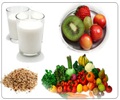CHOP's Possibilities Project introduces a tablet-based nutrition screener to connect eligible families with WIC and SNAP programs.

Connecting Families to Benefit Programs Through a Standardized Nutrition Screener
Go to source). Many low-income families rely on the federally funded Special Supplemental Nutrition Program for Women, Infants, and Children (WIC) and the Supplemental Nutrition Assistance Program (SNAP) for nutritional support, and both programs have been linked to improved health outcomes and decreased health care costs. However, many eligible families do not receive these program benefits because of the complex application and enrollment process.
‘Researchers have created a simple screening tool to improve family access to federally funded #nutrition programs, aiming to ensure #healthier food resources for eligible families. #healthyeating #healthylifestyle
’





“Prior studies at CHOP show that 50% of people who are eligible for services like WIC might not actually be taking advantage of them,” said study co-author George Dalembert, MD, Associate Director of the Center for Health Equity at CHOP. Tablet-Based Nutrition Screener to Connect Families
The Possibilities Project at CHOP aims to design innovative strategies and implement new ideas to better serve patients. In this study, to help eligible families navigate this system, researchers designed and tested a standardized process for linking families to WIC and SNAP during pediatric primary care visits. This nutrition screener was a tablet-based questionnaire that asked eligible families whether they were interested in help applying for WIC or SNAP or wanted information about local food banks.Caregivers who requested help applying for WIC or SNAP received a phone call within a week offering targeted assistance with benefits enrollment. Information was also printed out during the office visit and linked to their child’s patient portal.
In the first month of the pilot in November 2022, 433 families completed the screener (74% in person, 26% via patient portal), and 73 (17%) requested nutrition resources, including 17 who requested information about local food banks, and 56 families who requested benefits application support. Of these 56 families, 25 (45%) were reached by telephone and 21 (38%) were successfully connected to WIC and/or SNAP or given the information they requested. However, many families (55%) could not be reached as they either had incorrect contact information listed in the electronic health record (12%) or did not respond to telephone calls from our resource navigator (43%).
“The approach we developed may be one important way to normalize social needs assessment and provide families with additional nutrition support,” said lead study author Aditi Vasan, MD, an attending physician with the Division of General Pediatrics at CHOP. “To ensure all families in need are able to receive appropriate support, clinics should consider priming caregivers to expect follow-up from a resource navigator, as well as asking about preferred contact method and incorporating additional outreach approaches like text messaging.”
Advertisement
- Connecting Families to Benefit Programs Through a Standardized Nutrition Screener - (https://www.annfammed.org/content/22/3/259)
Source-Eurekalert















